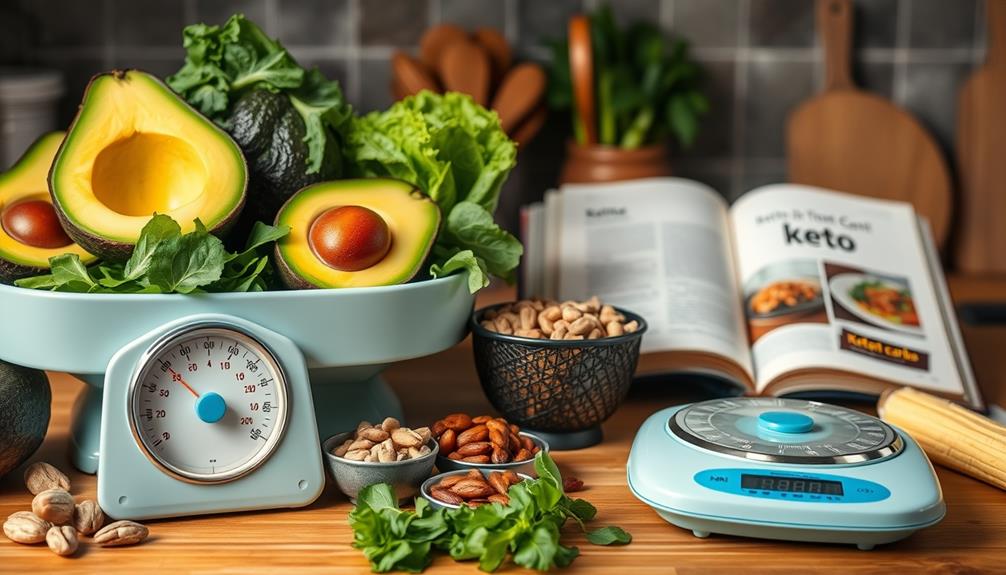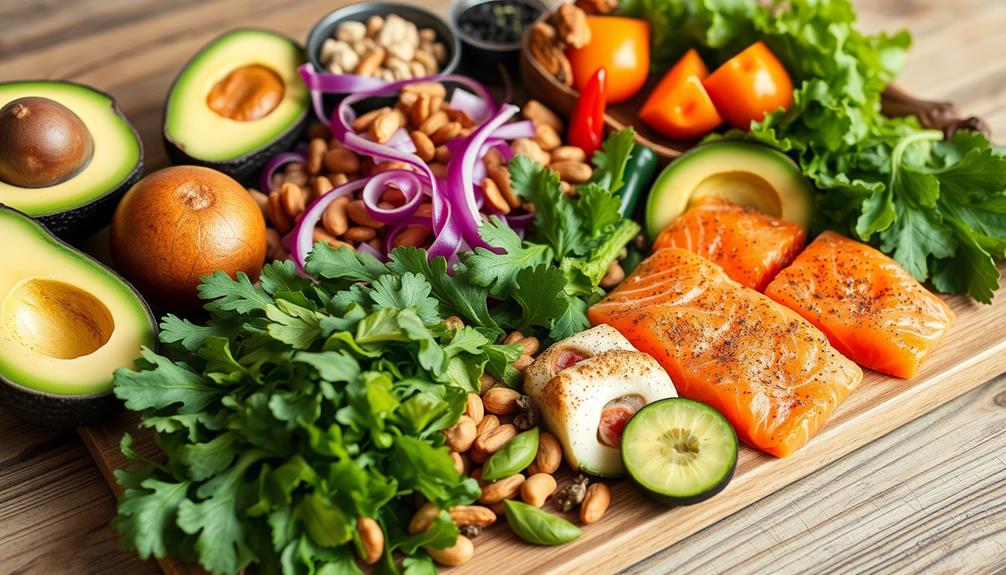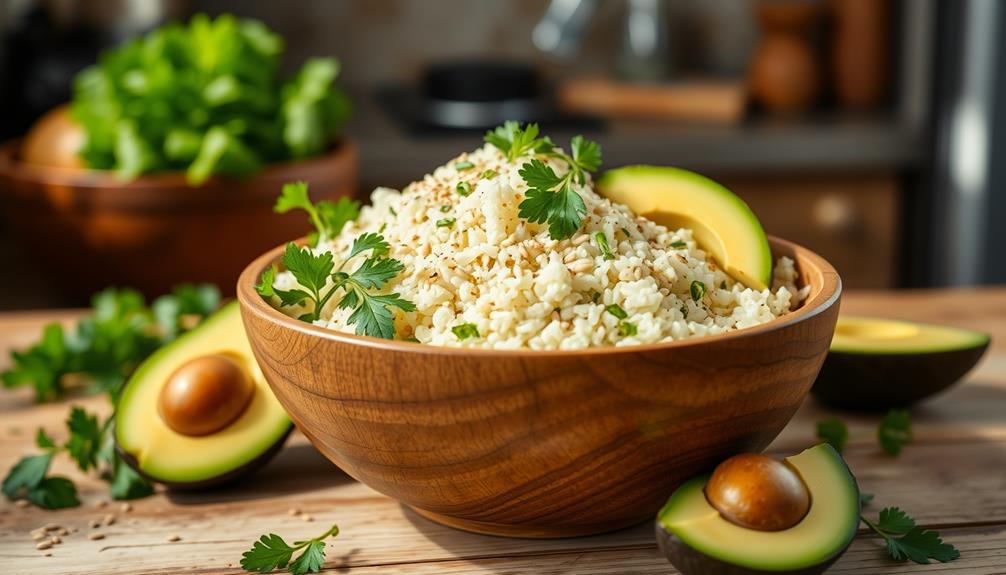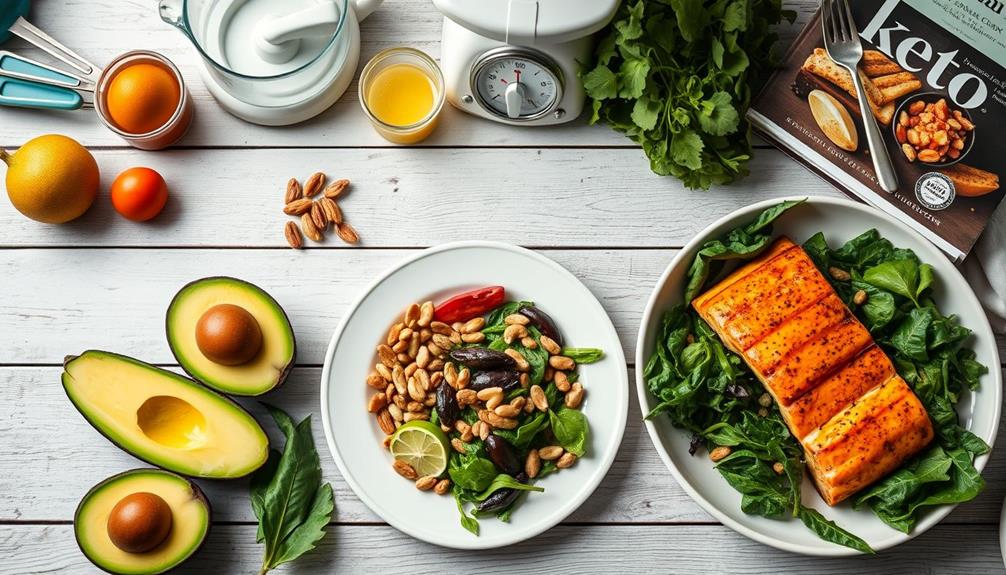On a keto diet, you should limit your net carbs to 20-50 grams per day to maintain ketosis. The lower end, around 20-30 grams, is often ideal for achieving the best results. To calculate net carbs, subtract fiber and sugar alcohols from total carbs. This approach lets you enjoy high-fiber foods that won't spike your blood sugar. Be mindful of hidden carbs in processed foods, sauces, and snacks, as they can easily add up. Staying aware of your carb intake is essential for success, and there's even more to learn about optimizing your keto journey.
Key Takeaways
- The ketogenic diet typically limits carbohydrate intake to under 50 grams per day, with 20-30 grams often considered ideal for ketosis.
- Net carbs, calculated by subtracting fiber and sugar alcohols from total carbohydrates, should be maintained between 20-50 grams daily.
- High-carb foods to avoid include bananas, potatoes, sugary drinks, and processed foods with hidden sugars.
- Maintaining a macronutrient ratio of 70-80% fat, 15-20% protein, and 5-10% carbohydrates is essential for the keto diet.
- Regular tracking of net carb intake is crucial for sustaining ketosis and achieving dietary goals.
Overview of the Keto Diet

The ketogenic diet, often simply called keto, is a high-fat, low-carbohydrate eating plan designed to shift your body into a state of ketosis, where it burns fat for fuel instead of carbs.
This approach to eating not only aids in weight loss but also promotes overall health by emphasizing nutrient-dense foods. Typically, the ketogenic diet limits carbohydrate intake to less than 50 grams of carbs per day, with some individuals finding even greater success on 20-30 grams for ideal ketosis.
The macronutrient ratio is about 70-80% fat, 15-20% protein, and 5-10% carbohydrates, emphasizing fat as the primary energy source.
For those considering this diet, it's essential to incorporate effective strategies for weight loss that can help maintain motivation and guarantee sustainable results.
Carbohydrate Limits Explained

When you're on a keto diet, understanding your daily carb limit is essential for staying in ketosis.
You'll want to calculate your net carbs by subtracting fiber and sugar alcohols from total carbs, which helps you track your intake more accurately.
Plus, be wary of hidden carbs in processed foods, as they can easily push you over your limits.
Daily Carb Limit
On a ketogenic diet, setting a daily carb limit is vital for achieving and maintaining ketosis. Typically, you should aim for under 50 grams of carbohydrates per day, with many people finding success in the range of 20-30 grams for ideal ketosis.
It's important to focus on net carbs, which means calculating total carbohydrates minus fiber and sugar alcohols, to effectively monitor your carb intake. Additionally, understanding how certain dietary choices can affect your overall health is significant, as seen in cold medications overview that provide insights into managing symptoms while on a restrictive diet.
Here are some key points to take into account:
- Personalization: Your daily carbohydrate intake may need to be adjusted based on your specific goals, activity levels, and metabolic responses.
- Macronutrient Ratio: A standard keto diet consists of approximately 75-80% fat, 15-20% protein, and only 5-10% carbohydrates.
- Hidden Carbs: Be vigilant about hidden carbs in processed foods, which can sneak into your diet and disrupt your ketosis.
Calculating Net Carbs
Calculating net carbs is essential for successfully guiding a ketogenic diet. You'll want to aim for an intake of 20 to 50 grams of net carbs per day to maintain ketosis and encourage fat burning. To calculate net carbs, subtract fiber and sugar alcohols from total carbohydrates listed on food labels. This way, you can focus on digestible carbs that actually impact your blood sugar levels.
Understanding concepts like investment goals can help you make informed decisions about your dietary choices.
High-fiber foods can be advantageous on a keto diet since fiber doesn't raise blood sugar and can be deducted from total carb counts. Understanding the difference between total carbohydrates and net carbs is vital for your success. Many food labels highlight total carbohydrates without addressing the influence of fiber, which can lead to miscalculations.
Be cautious of hidden carbs in processed foods, as even small amounts can disrupt your ability to maintain ketosis. Regularly tracking your net carb intake will help you stay on course.
Foods to Avoid
To maintain ketosis and reap the full benefits of a ketogenic diet, you'll need to be diligent about avoiding certain high-carb foods. Keeping your daily carb intake under 50 grams—ideally between 20-30 grams—will help you stay in ketosis.
Understanding the impact of various brewing methods on caffeine levels can also aid in choosing your beverages wisely, as some drinks may contain hidden sugars. Here are some key items to steer clear of:
- High-carb fruits: Bananas and grapes can exceed 20 grams of net carbs per serving.
- Starchy vegetables: Potatoes and corn contribute significant carb counts that can derail your progress.
- Sugary drinks: Sodas and sweetened beverages can pack 30-40 grams of sugar per serving.
Additionally, processed foods often contain hidden sugars and carbs, making it essential to read food labels carefully. Whole grains and legumes are typically prohibited as well; for instance, bread and pasta can have over 15 grams of net carbs per serving.
Understanding Net Carbs

Understanding net carbs is vital for anyone following a ketogenic diet, as it directly impacts your ability to achieve and maintain ketosis.
Net carbs are calculated by subtracting fiber and sugar alcohols from total carbohydrates, giving you a clearer picture of what affects your blood sugar levels. On a keto diet, it's generally recommended that you limit your net carbs to between 20 to 50 grams daily, with many finding ideal results at around 20-30 grams.
Additionally, incorporating high-fiber foods can enhance satiety and promote digestive health, making choices like celery juice beneficial for your overall keto plan. High fiber content in foods can lower net carb counts, making those options more suitable for your diet. Since fiber isn't digested, it won't interfere with your ketosis.
It's essential to start tracking net carbs diligently. Even foods with high fiber can still contribute to your total carbohydrates, which can hinder fat burning if consumed in excess.
Always read labels and understand the carbohydrate content of both processed and whole foods. By keeping a close eye on net carbs, you can navigate your dietary choices more effectively, ensuring that you stay on track with your keto journey.
Health Benefits of Keto

The ketogenic diet offers numerous health benefits that can enhance your overall well-being. By shifting your body into a state of ketosis, you can experience significant improvements in various health markers.
Additionally, understanding the financial aspects of health care, such as assisted living expenses, can provide a more thorough approach to maintaining a healthy lifestyle as you age.
Here are a few key benefits of the keto lifestyle:
- Weight Loss: Many participants have reported an average of 13% weight reduction in just 8 weeks, making it an effective strategy for shedding pounds.
- Improved Blood Sugar Control: Research shows that the ketogenic diet can enhance insulin resistance and help regulate blood sugar levels, which is particularly beneficial for those with type 2 diabetes.
- Better Cardiovascular Health: The diet has been linked to lower triglycerides and improved cholesterol profiles, contributing to overall cardiovascular health.
Additionally, the diet's ability to reduce hunger levels can support adherence to your weight loss goals.
Not only does the keto diet promote immediate weight loss, but it also offers long-term benefits when combined with healthy eating patterns, like the Mediterranean diet.
Embracing this lifestyle can lead to sustained health improvements and a better quality of life.
Common Mistakes to Avoid

When you're on a keto diet, it's easy to underestimate hidden carbs in processed foods, which can throw off your daily limits.
Individuals with certain mental health conditions, such as chronic feelings of emptiness, may find it even more challenging to adhere to dietary restrictions.
You might also be overeating protein, thinking it's harmless, but that can disrupt ketosis and hinder your progress.
Staying mindful of these common mistakes is key to successfully maintaining your keto lifestyle.
Underestimating Hidden Carbs
How often do you check the labels on your favorite foods? If you're on a keto diet, underestimating hidden carbs can derail your progress.
Many processed foods, sauces, and dressings contain sugars and carbs that can quickly add up, making it important to read labels carefully. Essential oils like eucalyptus oil can support respiratory health, but they won't help you avoid these hidden carbs.
Here are some common culprits to watch out for:
- Flavored yogurts: They can have over 20 grams of sugar per serving.
- Condiments: Ketchup and barbecue sauce may pack up to 15 grams of sugar each.
- Low-carb snacks: Some protein bars might contain 15-20 grams of hidden carbs.
To guarantee you stay within your carbs per day limit, it's vital to track food intake meticulously, including snacks and beverages.
Even foods marketed as low-carb can be deceptive, so don't let hidden carbs sabotage your efforts. Always opt for lower-carb alternatives, and use condiments sparingly.
Overeating Protein Sources
Many people on a keto diet mistakenly think that more protein means faster weight loss. In reality, overeating protein can trigger gluconeogenesis, where excess protein gets converted to glucose. This process can disrupt ketosis, preventing your body from effectively using fat for energy.
To maintain ketosis, it's essential to keep your protein intake in check, ideally between 0.7 to 0.9 grams per pound of body weight. Understanding the significance of balancing macros is key for success in any diet, including keto, and can enhance your overall health and wellness. Remember to reflect on different brewing methods that can affect your caffeine levels while on your diet journey.
While protein is important for preserving muscle mass, it shouldn't be your main energy source on a keto diet. Remember, the diet emphasizes high healthy fats and low carbs.
Also, be mindful of hidden carbs in common protein sources like certain meats and dairy. Tracking your total carbohydrate intake, including that from protein-rich foods, is critical to stay within the recommended 20-50 grams of net carbs per day.
To avoid protein overload, focus on incorporating healthy fats into your meals. Use fats as your primary calorie source while keeping protein at ideal levels for maintaining ketosis.
Balancing your macros will support your goals for weight loss and energy while helping you avoid common pitfalls.
Tools for Tracking Carbs
To effectively manage your carb intake on a keto diet, utilizing various tracking tools can make a significant difference. Incorporating strategies like developing a clear investment strategy for your dietary goals can help you stay focused and disciplined.
Here are some effective methods to help you stay on track:
- Carb Tracking Apps: Use apps like MyFitnessPal or Carb Manager to easily log food intake and track net carbs, ensuring you stay within the recommended 20-50 grams of net carbs per day for ketosis.
- Food Journals: Keeping a written food diary helps you document daily meals and snacks, allowing you to understand your carb consumption patterns better.
- Portion Control: Measuring portion sizes, especially for high-carb foods, is vital for accurate tracking and adherence to your daily carb limit.
Additionally, mastering food label reading is essential. Pay attention to total carbohydrates, fiber, and sugar alcohols to calculate net carbs accurately.
Consider using ketone testing kits like strips or blood meters to monitor your ketone levels, ensuring you're in ketosis based on your carb intake. By combining these tools, you'll improve your ability to track food intake and maintain your ketogenic diet effectively.
Foods to Include and Avoid

A well-planned ketogenic diet focuses on including high-fat, low-carb foods while avoiding those that can hinder your progress. To thrive on this diet, aim for foods to include that are rich in healthy fats and protein. Avocados, nuts, seeds, and fatty fish are excellent choices. Low-carb vegetables like spinach and broccoli also provide essential nutrients without spiking your carb intake.
Additionally, understanding the importance of key domains of development in psychology can aid in maintaining overall health and well-being, which is vital while on a restrictive diet.
On the flip side, there are specific foods to avoid that can derail your efforts. Steer clear of high-carb items, including grains, sugars, and starchy vegetables like potatoes and corn. Most fruits are off-limits, except for small portions of berries. Processed foods often contain hidden sugars and carbs, making them risky for your keto diet.
When tracking your daily intake, remember to focus on net carbs, calculated by subtracting fiber and sugar alcohols from total carbohydrates. This will help you maintain a state of ketosis.
Incorporate healthy fats from sources like olive oil and grass-fed butter, while avoiding unhealthy trans fats found in margarine and processed oils. With the right choices, you'll stay on track in your ketogenic journey.
Frequently Asked Questions
How Many Carbs Can I Eat and Stay in Ketosis?
To stay in ketosis, you should limit your daily carbohydrate intake to under 50 grams. Some people find success with even fewer carbs, around 20-30 grams. Always track your net carbs for better results.
Can You Lose Weight on 50 Carbs a Day?
Imagine shedding 13% of your weight in eight weeks. Yes, you can lose weight on 50 carbs a day, as many have found it effective for decreasing hunger and promoting fat loss. Stay committed!
Is 100 Carbs a Day Low Carb?
Yes, 100 carbs a day is considered low carb, but it's at the upper limit. If you want to experience the full benefits of a low carb diet, aim for under 50 grams daily.
How Many Carbs Does It Take to Kick You Out of Ketosis?
Carb consumption counts! Exceeding about 50 grams of net carbs daily can disrupt your ketosis, pushing your body back to burning glucose for energy. Keep track of hidden carbs to stay in that fat-burning zone!
Conclusion
In summary, sticking to a low carb intake is essential for your keto journey. Generally, you should aim for around 20 to 50 grams of net carbs daily to keep your body in ketosis. With the right tools and knowledge, steering through your food choices becomes a piece of cake—well, maybe not cake, but you get the idea! Embrace this lifestyle, and you'll reveal a world of health benefits that feels nothing short of extraordinary.









